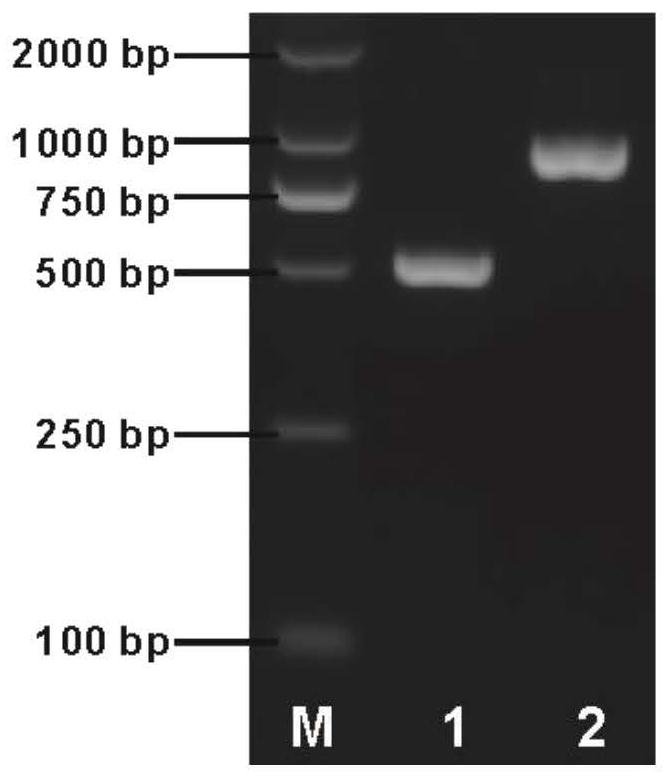Gene mutant of low-cadmium-accumulation control gene ZmCd1 of corn grains, molecular marker for gene mutant and application of gene mutant
A technology of molecular markers and low accumulation, applied in the fields of application, genetic engineering, plant gene improvement, etc., can solve the problems of inaccurate identification, shorten the process of identification and breeding, improve breeding efficiency, and be suitable for popularization and application
- Summary
- Abstract
- Description
- Claims
- Application Information
AI Technical Summary
Problems solved by technology
Method used
Image
Examples
Embodiment 1
[0032] Example 1 Obtaining of Maize ZmCd1 Gene Mutant ZmCd1-2
[0033] The method for measuring the cadmium content in corn kernels is as follows: corn is planted in cadmium-contaminated farmland (cadmium content is 1.8±0.3mg / kg), and the experiment adopts random block design, with four independent repetitions. For each independent repetition, the same maize inbred line was planted in a row, 10 plants were planted in a row, and the row length was 3m. The row spacing of each interbreeding line is 60cm. Maize ears were dried and threshed after maturity. For each repetition of each inbred line, 1 kg of kernels were dried and crushed, passed through a 100-mesh sieve, and then digested with nitric acid-perchloric acid. Finally, ZEEnit700P atomic absorption spectrometer was used for graphite furnace Determination of cadmium content (mg / kg) in digestive juice (Wu Jiamei, 2019, Journal of Agro-Environment Science, 38:502-509). Data from the four environments were integrated using Be...
Embodiment 2
[0035] Example 2 cDNA sequence analysis of the allelic variation ZmCd1-2 controlling the low accumulation of cadmium in corn grain
[0036] RNA was extracted from Ky21 maize leaves by TRIZOL method, and RNA was reverse transcribed into cDNA by reverse transcription kit (Takara). Using the 3'-RACE kit (Takara) and the 1219F primer located on the 4th exon (Table 1), the transcript sequence behind the 4th exon and the complete 3' end sequence were obtained. Compared with B73, sequencing analysis found that there were two shorter transcripts of ZmCd1-2 in Ky21. The fifth exon of the first transcript was not transcribed, and a 130 bp transposon insertion sequence and a 9 bp intronic sequence were exonized after the fourth exon. The 5th exon in the second transcript is also not transcribed, and a 216 bp transposon insertion after the 4th exon is exonized (see figure 2 ).
[0037] Table 1 is located on the 4th exon and is used for the amplification primer of ZmCd1-2 gene cDNA 3'-...
Embodiment 3
[0039] Example 3 Development and Application of Specific Functional Molecular Markers of Maize ZmCd1 Gene Mutant ZmCd1-2
[0040] Based on the sequence difference between the high cadmium accumulation corn inbred line Ky21 and the low cadmium accumulation corn inbred line B73 in the fourth intron of the ZmCd1 gene, a PCR functional molecular marker PCR-ZmCd1-2 was developed, and its primer information is shown in Table 2. Using 204F / 732R / 965R primers, the amplified fragment size was 965bp in the high cadmium accumulation maize inbred line Ky21, and the amplified fragment size was 529bp in the low cadmium accumulation maize inbred line B73 ( image 3 ).
[0041] Table 2 PCR-ZmCd1-2 functional molecular marker primer information
[0042] Primer 5'-3' sequence 204F GACGTTCTGGAGTCGCTGG 965R ACGTCAAGCAGATAAGGGCC 732R GGTCCTACAGTCGTCCGAGA
PUM
 Login to View More
Login to View More Abstract
Description
Claims
Application Information
 Login to View More
Login to View More - R&D
- Intellectual Property
- Life Sciences
- Materials
- Tech Scout
- Unparalleled Data Quality
- Higher Quality Content
- 60% Fewer Hallucinations
Browse by: Latest US Patents, China's latest patents, Technical Efficacy Thesaurus, Application Domain, Technology Topic, Popular Technical Reports.
© 2025 PatSnap. All rights reserved.Legal|Privacy policy|Modern Slavery Act Transparency Statement|Sitemap|About US| Contact US: help@patsnap.com



